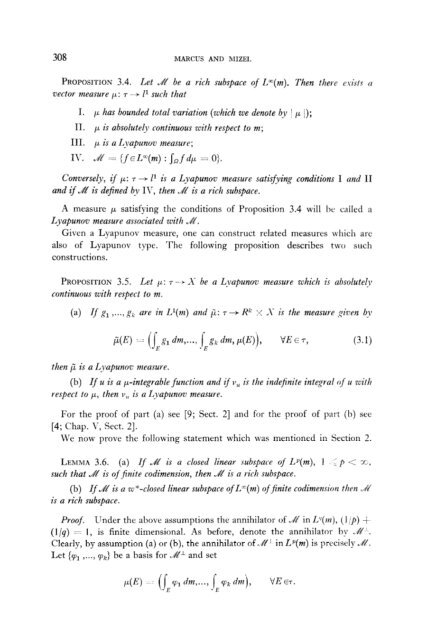Extension Theorems of Hahn-Banach Type for Nonlinear Disjointly ...
Extension Theorems of Hahn-Banach Type for Nonlinear Disjointly ...
Extension Theorems of Hahn-Banach Type for Nonlinear Disjointly ...
You also want an ePaper? Increase the reach of your titles
YUMPU automatically turns print PDFs into web optimized ePapers that Google loves.
308 MARCUS AND MIZEI.<br />
PROPOSITION 3.4. Let ~2’ be a rich subspace <strong>of</strong> L”(m). Then. there e.rists a<br />
vector measure p: 7 + I1 such that<br />
I. TV has bounded total variation (which we denote by j p I);<br />
II. TV is absolutely continuous with respect to m;<br />
III. p is a I.yapunov measure;<br />
IIT. &? =: {f ELm(m) : Snf dW = O}.<br />
Conversely, if TV: 7 ---+ l1 is a Lyapunov measure satisfying conditions I and II<br />
and if AS? is de$ned by IV, then Jd is a rich subspace.<br />
A measure p satisfying the conditions <strong>of</strong> Proposition 3.4 will bc called a<br />
Lyapunov measure associated with JY.<br />
Given a Lyapunov measure, one can construct related measures which arc<br />
also <strong>of</strong> Lyapunov type. The f o 11 owing proposition describes two such<br />
constructions.<br />
PROPOSITION 3.5. Let TV: 7 - l X be a Lyapunov measure which is absolutely<br />
continuous with respect to m.<br />
(a) If gl ,..., g,. are in Ll(m) and p: 7 + Rk :< S is the measure given bzl<br />
then j.2 is a Lyapunov measure.<br />
F(E) .-z (lEgl dm ,... , .kg, dnz, p(E)), VE E 7, (3.1)<br />
(b) If u is a p-integrable function and af 1/U is the indefinite integral <strong>of</strong> u z&h<br />
respect to p, then vl, is a Lyapunov measure.<br />
For the pro<strong>of</strong> <strong>of</strong> part (a) see [9; Sect. 21 and <strong>for</strong> the pro<strong>of</strong> <strong>of</strong> part (1~) see<br />
[4; Chap. V, Sect. 21.<br />
We now prove the following statement which was mentioned in Section 2.<br />
LEMMA 3.6. (a) If J&’ is a closed linear subspace <strong>of</strong> LY(m), 1 ; p < z,<br />
such that A? is <strong>of</strong> $nite codimension, then At is a rich subspace.<br />
(b) If .Ad is a w*-closed linear subspace <strong>of</strong> Lx(m) <strong>of</strong> Ji ni t e codimension then A<br />
is a rich subspace.<br />
Pro<strong>of</strong>. Under the above assumptions the annihilator <strong>of</strong> JZZ’ in L”(M), (1 /p) +<br />
(l/q) :: I, is finite dimensional. i2s be<strong>for</strong>e, denote the annihilator by k’ .<br />
Clearly, by assumption (a) or (b), the annihilator <strong>of</strong> .~&‘l in Ln(m) is precisely JZ.<br />
Let (ql ,..., pk) be a basis <strong>for</strong> J&‘~ and set

















